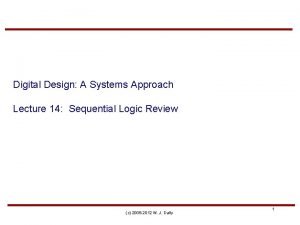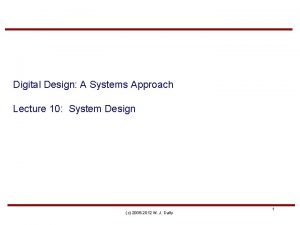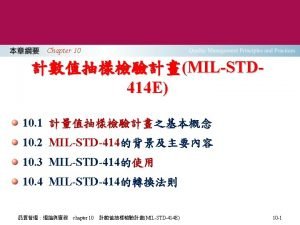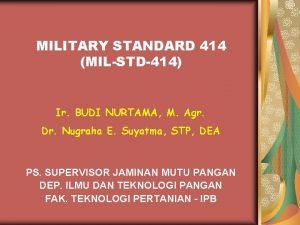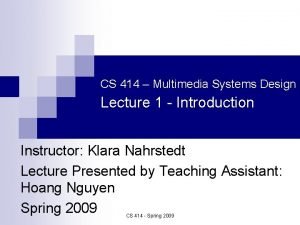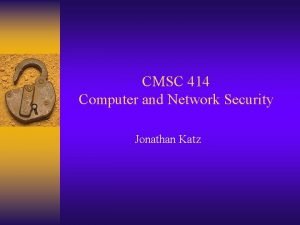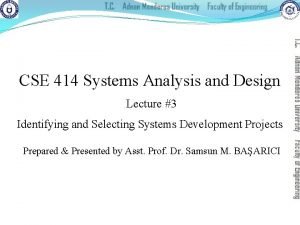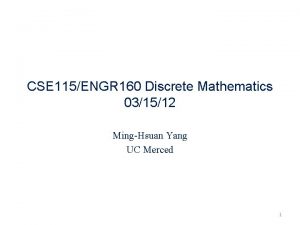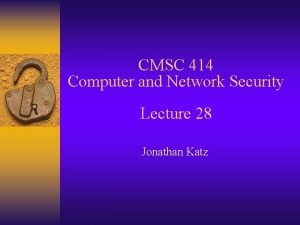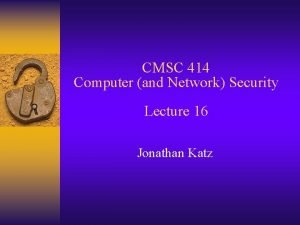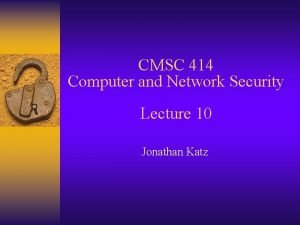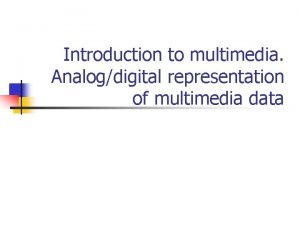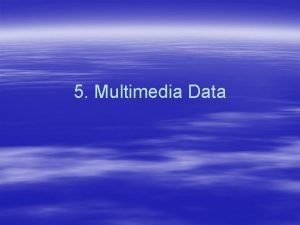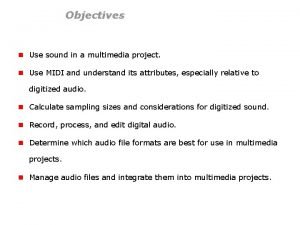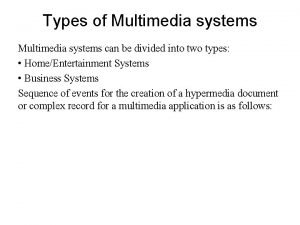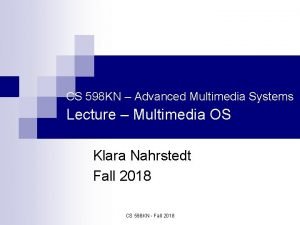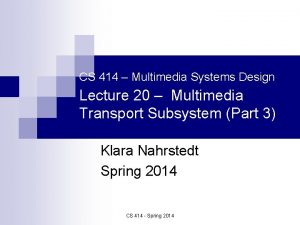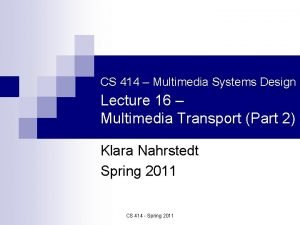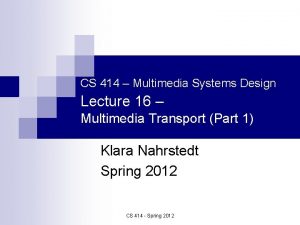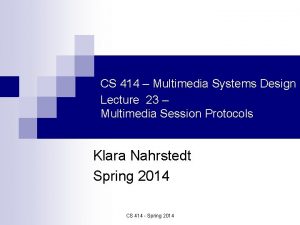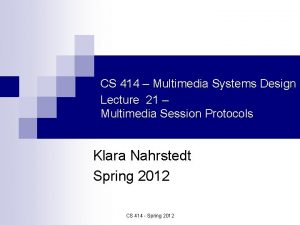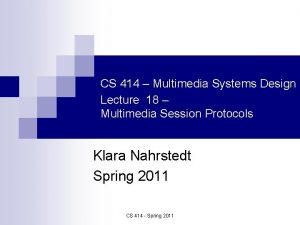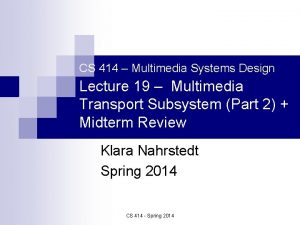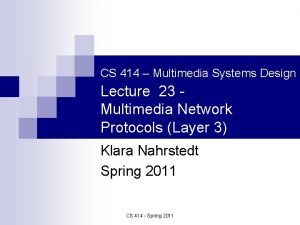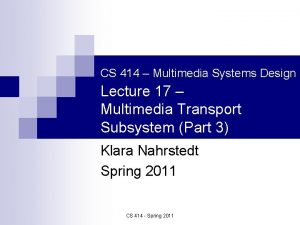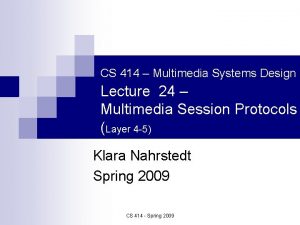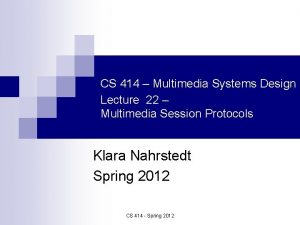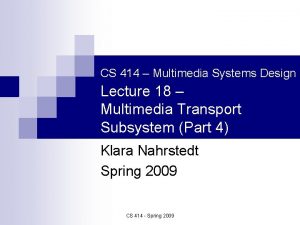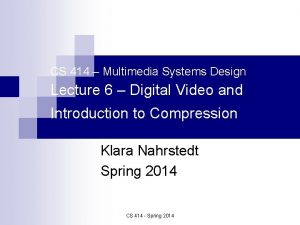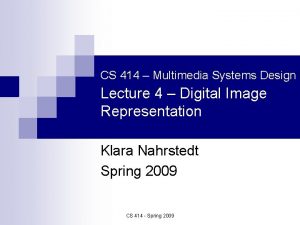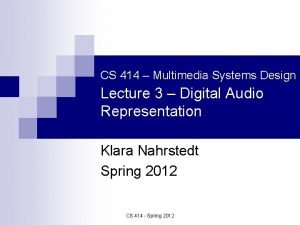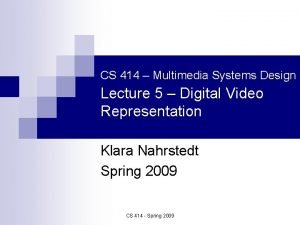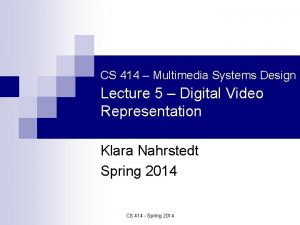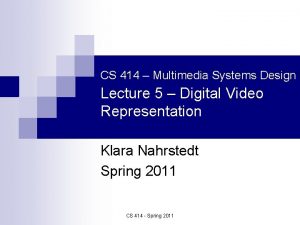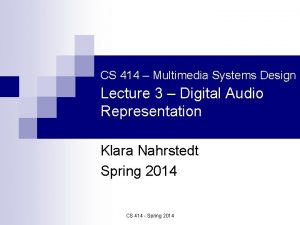CS 414 Multimedia Systems Design Lecture 5 Digital


































- Slides: 34

CS 414 – Multimedia Systems Design Lecture 5 – Digital Video Representation Klara Nahrstedt Spring 2012 CS 414 - Spring 2012

Administrative n MP 1 will be out (January 30) ¨ Deadline of MP 1 is February 18 (Saturday), 5 pm ¨ You can have 2 bonus day if needed (just keep in mind that you can have totally 3 bonus days for all three MPs) ¨ Submit via compass n MP 1 discussion during Lecture on February 1 CS 414 - Spring 2012

Today Introduced Concepts n Digital Image Representation ¨ Quantization, n Video – Additional Visual Perception Dimensions ¨ Resolution, n Color Issues, Image Size Brightness, Temporal Resolution Television ¨ Analog, Digital ¨ NTSC, HDTV, … CS 414 - Spring 2012

Color Quantization Example of 24 bit RGB Image 24 -bit Color Monitor CS 414 - Spring 2012

Image Representation Example 24 bit RGB Representation (uncompressed) 128 135 166 138 190 132 129 255 105 189 167 190 229 213 134 111 138 187 135 255 213 190 167 138 129 229 138 189 111 Color Planes 166 105 134 132 190 187

Image Properties (Color) CS 414 - Spring 2012

Color Histogram CS 414 - Spring 2012

Spatial and Frequency Domains n Spatial domain ¨ refers to planar region of intensity values at time t n Frequency domain ¨ think of each color plane as a sinusoidal function of changing intensity values ¨ refers to organizing pixels according to their changing intensity (frequency) CS 414 - Spring 2012

Image Size (in Bits) n Image Size = Height x Width X Bits/pixel n Example: ¨ Consider image 320 x 240 pixels with 8 bits per pixel ¨ Image takes storage 7680 x 8 bits = 61440 bits or 7680 bytes CS 414 - Spring 2012

VIDEO CS 414 - Spring 2012

What is Video? n 300 image frames CS 414 - Spring 2012

Visual Perception: Resolution and Brightness n Visual Resolution (depends on: ) Image size ¨ Viewing distance ¨ n Brightness Perception of brightness is higher than perception of color ¨ Different perception of primary colors n Relative brightness: green: red: blue= ¨ 59%: 30%: 11% CS 414 - Spring 2012 Source: wikipedia

Visual Perception: Resolution and Brightness CS 414 - Spring 2012

Visual Perception: Temporal Resolution n Effects caused by inertia of human eye Perception of 16 frames/second as continuous sequence Special Effect: Flicker CS 414 - Spring 2012

Temporal Resolution n Flicker ¨ Perceived if frame rate or refresh rate of screen too low (<50 Hz) ¨ Especially in large bright areas n Higher refresh rate requires: ¨ Higher scanning frequency ¨ Higher bandwidth CS 414 - Spring 2012

Visual Perception Influence Viewing distance n Display ratio n ¨ width/height – 4/3 for conventional TV ¨ Width/height – 16/9 for HDTV Number of details still visible n Intensity (luminance) n CS 414 - Spring 2012

Television History (Analog) n 1927, Hoover made a speech in Washington while viewers in NY could see, hear him n AT&T Bell Labs had the first “television” ¨ 18 fps, 2 x 3 inch screen, 2500 pixels

Analog Television Concepts n n n Production (capture) ¨ 2 D ¨ structured formats Representation and Transmission ¨ popular formats include NTSC, PAL, SECAM Re-construction ¨ scanning ¨ display issues (refresh rates, temporal resolution) ¨ relies on principles of human visual system CS 414 - Spring 2012

Color Space: YUV n PAL video standard ¨Y is luminance ¨ UV are chrominance n Y YUV from RGB Y =. 299 R +. 587 G +. 114 B U = 0. 492 (B - Y) V = 0. 877 (R - Y) U-V plane at Y=0. 5 U V CS 414 - Spring 2012 Source: wikipedia

YIQ (NTSC) n YIQ from RGB Y =. 299 R +. 587 G +. 114 B I =. 74 (R - Y) -. 27 (B - Y) Q = 0. 48 (R - Y) + 0. 41 (B Y) CS 414 - Spring 2012 YIQ with Y=0. 5 Source: wikipedia

Video Representations CS 414 - Spring 2012

TV History CS 414 - Spring 2012

HDTV (Digital) n Resolutions: ¨ 1920 x 1080 (1080 p) – Standard HD (HDTV) ¨ 2160 p, … ¨ 4096 x 2304 (4096 p) – 4 K High HD n Frame rate: ¨ HDTV - 50 or 60 frames per second ¨ HDTV – 120 fps CS 414 - Spring 2012

HDTV n Interlaced (i) and/or progressive (p) formats ¨ Conventional TVs – use interlaced formats ¨ Computer displays (LCDs) – use progressive scanning MPEG-2 compressed streams n In Europe (Germany) – MPEG-4 compressed streams n CS 414 - Spring 2012

Pixel Aspect Ratio • Analog TV counts lines, digital television counts pixels • Computer Graphics parameter • Mathematical ratio describing horizontal length of a pixel to its vertical height • Used mainly in digital video editing software to properly scale and render video Into a new format CS 414 - Spring 2012 Source: wikipedia

Aspect Ratio and Refresh Rate n Aspect ratio Conventional TV is 4: 3 (1. 33) ¨ HDTV is 16: 9 (2. 11) ¨ Cinema uses 1. 85: 1 or 2. 35: 1 ¨ n Frame Rate ¨ NTSC is 60 Hz interlaced (actually 59. 94 Hz) ¨ PAL/SECAM is 50 Hz interlaced ¨ Cinema is 24 Hz noninterlaced CS 414 - Spring 2012 Source: wikipedia

Resolution CS 414 - Spring 2012

3 DTV Refresh rate no less than 120 Hz n Synchronized shutter glasses to enable different views for different eyes n CS 414 - Spring 2012

Digital Video and TV n n Bit rate: amount of information stored per unit time (second) of a recording Color Coding: YCr. Cb of YUV that scales and shifts the chrominance values into range 0. . 1 Y ¨ Subset Y = 0. 299 R + 0. 587 G +. 114 B Cr = ((B-Y)/2) + 0. 5 Cb = ((R-Y)/1. 6) + 0. 5 CS 414 - Spring 2012 Cr Cb

Digital Video and TV n Color space compression ¨ YUV 444 n 24 bits per pixel ¨ YUV 422 n 16 bits/pixel ¨ YUV 411 n 12 bits/pixel CS 414 - Spring 2012

Digital Video and TV n DVD video ¨ Since 1997 ¨ Resolution and frame rate 704 x 480 at 29. 97 fps n 704 x 576 at 25 fps n ¨ Bitrate: 9. 8 Mbps CS 414 - Spring 2012

Digital Video and TV n Blu-ray video since 2006 ¨ Resolution and frame rate ¨ 1920 i (@59. 94 fps) – interlaced n 1920 p (@24 fps) – progressive n …. n ¨ Bitrate : 40 Mbps CS 414 - Spring 2012

Summary n Digitization of Video Signals ¨ Composite Coding ¨ Component Coding n Digital Television (DTV) ¨ DVB (Digital Video Broadcast) Satellite connections, CATV networks – best suited for DTV n DVB-S – for satellites (also DVB-S 2) n DVB-C – for CATV n CS 414 - Spring 2012

SMPTE Time Codes n n Society of Motion Picture and Television Engineers defines time codes for video ¨ HH: MM: SS: FF ¨ 01: 12: 59: 16 represents number of pictures corresponding to 1 hour, 12 minutes, 59 seconds, 16 frames n If we consider 30 fps, then 59 seconds represent 59*30 frames, 12 minutes represent 12*60*30 frames and 1 hour represents 1*60*60*30 frames. For NTSC, SMPTE uses a 30 drop frame code ¨ increment as if using 30 fps, when really NTSC has only 29. 97 fps ¨ defines rules to remove the difference error CS 414 - Spring 2012
 01:640:244 lecture notes - lecture 15: plat, idah, farad
01:640:244 lecture notes - lecture 15: plat, idah, farad Digital systems testing and testable design
Digital systems testing and testable design Digital design: a systems approach
Digital design: a systems approach Digital design a system approach
Digital design a system approach Digital system design using verilog
Digital system design using verilog Multimedia becomes interactive multimedia when
Multimedia becomes interactive multimedia when Linear vs nonlinear multimedia
Linear vs nonlinear multimedia Csc253
Csc253 Esa multimedia.esa.int./multimedia/virtual-tour-iss
Esa multimedia.esa.int./multimedia/virtual-tour-iss Mil-std-414
Mil-std-414 Mil std 414
Mil std 414 Mil-std 414
Mil-std 414 414 climate change
414 climate change Cs 414
Cs 414 Cmsc 414
Cmsc 414 Cse414
Cse414 Gcd of 414 and 662
Gcd of 414 and 662 Cmsc 414
Cmsc 414 Cmsc 414
Cmsc 414 Cmsc 414
Cmsc 414 Operating systems lecture notes
Operating systems lecture notes Lecture sound systems
Lecture sound systems Lecture sound systems
Lecture sound systems Video representation in multimedia
Video representation in multimedia Introduction to digital video
Introduction to digital video Multimedia data
Multimedia data Video berasal dari kata latin yang artinya
Video berasal dari kata latin yang artinya Adding sound to your multimedia project
Adding sound to your multimedia project Definisi multimedia
Definisi multimedia Analog and digital video in multimedia
Analog and digital video in multimedia Multimedia divides into which two categories
Multimedia divides into which two categories Introduction of multimedia
Introduction of multimedia Advanced multimedia systems
Advanced multimedia systems Multimedia database management systems
Multimedia database management systems Eurocode 2 lap length table
Eurocode 2 lap length table


